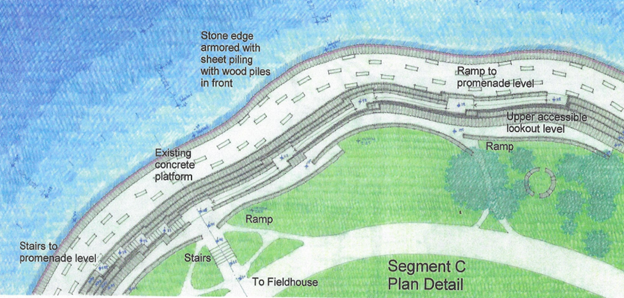It's time to listen to the community and let the community lead: this is what we've been saying we want for 25 years
- maximum historic limestone: retain and repair-in-place per Secretary of the Interior Standards for the Treatment of Historic Properties and the Guidelines for the Treatment of Cultural Landscapes
- minimum concrete: rehabilitation per Secretary of the Interior standards for Universal Design Access upgrades (ADA compliance) and minimum disruption of park use
- a sustainable, ecological solution (no demolition, minimal concrete, no clear-cutting of trees for demolition, no closing of the park for 5 years)
- creative, innovative, safe and generous Universal Design Access (ADA compliance) for all to both the revetment promenade and the water
- genuine community input into the design and construction happening at the Point
Promontory Point Conservancy announces new structural and coastal engineering studies that marry preservation and coastal resilience for Promontory Point’s limestone revetment
Promontory Point Conservancy, McLaren Engineering Group, and Wiss, Janney, Elstner Associates are pleased to announce the results of four structural, coastal engineering studies concerning the future of Chicago’s Promontory Point. The findings of our engineering studies prove tha the Point's limestone revetment hasn't failed and can be fixed and repaired to meet storm damage and shoreline protection requirements. And it's all less expensive than the Army Corps and the Chicago Dept. of Transportation's plan. Watch how it all works here.
A preservation appraoch to design and construction can realistically and cost-effectively meet shoreline proteciton and coastal resilience requirements, all to high degrees of scientific and engineering certainty. These engineering studies prove that the existing limestone block revetment :
A preservation appraoch to design and construction can realistically and cost-effectively meet shoreline proteciton and coastal resilience requirements, all to high degrees of scientific and engineering certainty. These engineering studies prove that the existing limestone block revetment :
- has NOT failed
- functions in good condition right now for storm damage and shoreline protection
- can be retained, repaired and rehabilitated to meet both preservation standards AND coastal resilience and erosion requirements
- can be rehabilitated in less than two years and in sections so that as much as 80% of the Point stays open to the public at any one time
- does not require clear-cutting all the trees along the perimeter of the revetment and into the meadow for staging
- can be adapted for Universal Design Access (ADA compliance) in three places
- can be repaired and rehabilitated at less than the cost of demolition and new concrete construction
- if repaired and maintained, has another 100 years of service
Our four incontestable studies prove that demolition and a new concrete revetment, as intended by USACE, CDOT and CPD, are wholly unnecessary and more expensive than repair and rehabilitation of the existing structure. You may find our recent studies here:
These four studies also emphasize the need for genuine, interactive public input into any design and construction at the Point, a stark contrast to the top-down, non-transparent efforts of USACE, CDOT and CPD. The Conservancy once again invites these agencies to collaborate with the community and their elected representatives to develop a solution suiting the interests and needs of all. Preserving the limestone is preserving the community that has gathered at the Point for decades. From our ten community meetings, came these FAQs with answers from our coastal and structural engineers.
- Alternatives Design Study, factsheet and cost-comparison examples
- Coastal Vulnerability Analysis and factsheet
- Historic Structure Report and factsheet
- Condition Study and factsheet
These four studies also emphasize the need for genuine, interactive public input into any design and construction at the Point, a stark contrast to the top-down, non-transparent efforts of USACE, CDOT and CPD. The Conservancy once again invites these agencies to collaborate with the community and their elected representatives to develop a solution suiting the interests and needs of all. Preserving the limestone is preserving the community that has gathered at the Point for decades. From our ten community meetings, came these FAQs with answers from our coastal and structural engineers.
Multiple designs for universal access upgrades and Universal Design Access (ADA compliance) at three locations meet Secretary of the Interior rehabilitation standards and retain the historic fabric of the existing structure, and determines both the Alternatives Design Study and the Historic Structure Report, released January 2025.
Dating from 2003, this drawing shows one option for universal access and Universal Design Access (ADA compliance) to the promenade and water for all on the east end of Promontory Point, where the 1965 concrete platform with wave deflectors -- called the "coffins" by the public -- forms the promenade. Accessibility ramps and long-tred, low-rise stairs connect the coffin promenade to the nearby fieldhouse washrooms and the walking pathways.
Other important resources:
Landmark Designation Report: Promontory Point, City of Chicago, Dept. of Planning and Development, March 9, 2023
National Register nomination report, Promontory Point, November 2017
McLaren’s credentials on U.S. Army Corps waterfront projects
Landmark Designation Report: Promontory Point, City of Chicago, Dept. of Planning and Development, March 9, 2023
National Register nomination report, Promontory Point, November 2017
McLaren’s credentials on U.S. Army Corps waterfront projects
